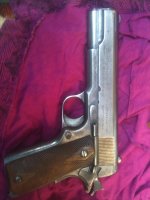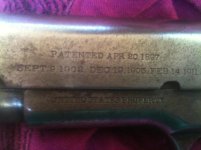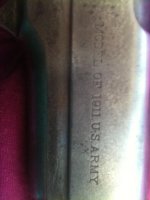You are using an out of date browser. It may not display this or other websites correctly.
You should upgrade or use an alternative browser.
You should upgrade or use an alternative browser.
colt 1911
- Thread starter zovek
- Start date
Winchester_73
New member
Looks to be pre black army based on SN. These have some value even in this condition. Neat piece of history. Good luck.
That old fellow was quite a bit before the "black army" of 1918, but it sure looks like it has a lot of history and the old saying, "If if could only talk" applies. My guess is that it was "rode hard and put away wet" in a couple of big wars and lots of little ones.
Condition-obsessed collectors would not consider even owning such a gun, but I think it safe to say it is more a part of history than any 100% museum piece.
Jim
Condition-obsessed collectors would not consider even owning such a gun, but I think it safe to say it is more a part of history than any 100% museum piece.
Jim
Baba Louie
New member
Buying for collecting or shooting? As I'm sure you are aware, heat treatment back in the day was... well, not very good compared to current knowledge and metallurgy, so do take care should you decide to shoot it. Hate to break something on the old timer.
Nice looking handgun. BTDT and it shows.
ETA Welcome to TFL
Nice looking handgun. BTDT and it shows.
ETA Welcome to TFL
Last edited:
Buying for collecting or shooting? As I'm sure you are aware, heat treatment back in the day was... well, not very good compared to current knowledge and metallurgy, so do take care should you decide to shoot it. Hate to break something on the old timer.
Nice looking handgun. BTDT and it shows.
I'd like to echo what Baba Louie just posted.
Zovek:
What you're looking at is a real 1911, a model of 1911, US Property marked and a historical piece
Little finish lefty obviously, but a wealth of service to country and private owner
original models of 1911 like this should not be used as shooters in many opinions, including mine. The breech face was often 'soft' on these pistols and by the 1930s Colt introduced a breech plug
That said, my own 1918 production model of 1911 was fired extensively and shows no peening. However I still caution against buying as a shooter
A wonderful historical piece however
A couple of areas of the slide, specifically the front and the area around the slide stop notch were later hardened even before Colt went to the "hard slide" in the Post WWII period. But the army kept M1911's in service until the end of the .45 era with no special caution about firing them.
I would not be concerned about moderate firing with standard pressure loads; that is what they were made for.
Jim
I would not be concerned about moderate firing with standard pressure loads; that is what they were made for.
Jim
Hi Tim
Can you explain about this please?
Can you explain about this please?
"...heat treatment back in the day was..." Irrelevant.
BUY IT!!! if you want to shoot it take it to a good gun smith have it checked out thoroughly. It's a piece of American history that's being sucked up fast. Colts are known world wide.I've got a 1903 A1 the crown of my collection that i shoot on special occasion. if it were me id find a few more WW artifacts and make a display case for those men who stormed the beaches of the pacific and france, but that's just me I'm a huge history buff. 
Aguila Blanca
Staff
The Army had no concerns about shooting them because the Army had armories with racks of replacement slides for when a slide broke. Collectors don't have that luxury. An authentic M1911 or M1911A1 in any original condition should not be fired. It's not that it's unsafe and will injure the shooter. It's simply that there is no way to predict when (not "if") the next shot will be the shot that breaks the front off the slide and renders the pistol both useless and valueless.James K said:But the army kept M1911's in service until the end of the .45 era with no special caution about firing them.
I would not be concerned about moderate firing with standard pressure loads; that is what they were made for.
In the interests of more discussion, I would like to add a little to A-B's points
The first thing would be that 'hard slides' were not introduced until 1947, well after Model of 1911 production ceased, and also, while experiments in hard slides were conducted in WWII, they were not standard issue. Add to that that military contract 1911A1 production ceased production in 1945
Prior to the hard slides, slides were heat treated to varying degrees of success. When new, given the expected lifespan of a pistol in say, wartime, the needs of the services were different than the needs of a recreational or competitive shooter- as A-B says, we don;t have stockpiles of spares hanging out 'for free'
I have seen photos of the next thing I'd like to mention, on improperly-made slides on modern 1911 type pistols- recession or peening of the breech face, in a ring around the firing pin. This seems like a dangerous thing to me. I know some people don't want to hear it, but this was a problem large enough for Colt to address the issue in the '30s, and at the time, the oldest 1911 was "only" 23 years old. They installed a recoil plate. But steel does not get stronger with age- another thing people don't want to hear- and if a 1911 didn't get the recoil plate, the 'soft' breech face is a real consideration in my opinion. Not all of them had or have this issue. Mine doesn't, it's from 1918 and was used as a target pistol. Shot very often before I bought it. No pitting or peening is present on the breech face. A slight discoloration is present but that's it. I have had people question me on that, saying they never heard of this peening or that it was considered an issue. I offer this image

Let's look too at the time difference between the present and time of manufacture. When, for example, my 1911 was used for target shooting, it was the 1950s, 60s, 70s, 80s, maybe even the '90s. We've added for the sake of argument another two decades to that time since it was made. That was 93 years ago. can I expect the steel in the pistol to be as strong as it was in 1918 forever? When can I expect it to fail? Just how many rounds has it had through it?
Yes, the pistol was made to shoot. But it is not 1930 or 1950 or 1970 or even 1990 any more. Was the pistol made to be an everlasting object that time would never effect? The answer must be 'no', mustn't it?
And in regard to the pistol as an object, this is part of what I touched on when I asked Tim O'Heir to expand on his comment: the pistol is only original once. more use equals more wear, by definition. You cannot use a thing and not cause wear to it it to some degree. In Tim's example, I believe he means that it is irrelevant because it shouldn't be used anyway. But to me, I recognize that I cannot control what has happened in the time when I did not own the thing, so it has been fired before and, as he mentions, the thing is "not an everyday shooter". The heat treatment, to me, absolutely makes a difference, since 1 round or 10,000, I cannot predict what can happen to the pistol, and therefore I am risking it's condition and value to one degree or another even on a pistol I only shoot on rare occasions
That said, I shoot my own Model of 1911 every July 4th. Calculated risk to condition on a non-perfect example is acceptable to me, and the pistol shows no sign of damage
The first thing would be that 'hard slides' were not introduced until 1947, well after Model of 1911 production ceased, and also, while experiments in hard slides were conducted in WWII, they were not standard issue. Add to that that military contract 1911A1 production ceased production in 1945
Prior to the hard slides, slides were heat treated to varying degrees of success. When new, given the expected lifespan of a pistol in say, wartime, the needs of the services were different than the needs of a recreational or competitive shooter- as A-B says, we don;t have stockpiles of spares hanging out 'for free'
I have seen photos of the next thing I'd like to mention, on improperly-made slides on modern 1911 type pistols- recession or peening of the breech face, in a ring around the firing pin. This seems like a dangerous thing to me. I know some people don't want to hear it, but this was a problem large enough for Colt to address the issue in the '30s, and at the time, the oldest 1911 was "only" 23 years old. They installed a recoil plate. But steel does not get stronger with age- another thing people don't want to hear- and if a 1911 didn't get the recoil plate, the 'soft' breech face is a real consideration in my opinion. Not all of them had or have this issue. Mine doesn't, it's from 1918 and was used as a target pistol. Shot very often before I bought it. No pitting or peening is present on the breech face. A slight discoloration is present but that's it. I have had people question me on that, saying they never heard of this peening or that it was considered an issue. I offer this image

Let's look too at the time difference between the present and time of manufacture. When, for example, my 1911 was used for target shooting, it was the 1950s, 60s, 70s, 80s, maybe even the '90s. We've added for the sake of argument another two decades to that time since it was made. That was 93 years ago. can I expect the steel in the pistol to be as strong as it was in 1918 forever? When can I expect it to fail? Just how many rounds has it had through it?
Yes, the pistol was made to shoot. But it is not 1930 or 1950 or 1970 or even 1990 any more. Was the pistol made to be an everlasting object that time would never effect? The answer must be 'no', mustn't it?
And in regard to the pistol as an object, this is part of what I touched on when I asked Tim O'Heir to expand on his comment: the pistol is only original once. more use equals more wear, by definition. You cannot use a thing and not cause wear to it it to some degree. In Tim's example, I believe he means that it is irrelevant because it shouldn't be used anyway. But to me, I recognize that I cannot control what has happened in the time when I did not own the thing, so it has been fired before and, as he mentions, the thing is "not an everyday shooter". The heat treatment, to me, absolutely makes a difference, since 1 round or 10,000, I cannot predict what can happen to the pistol, and therefore I am risking it's condition and value to one degree or another even on a pistol I only shoot on rare occasions
That said, I shoot my own Model of 1911 every July 4th. Calculated risk to condition on a non-perfect example is acceptable to me, and the pistol shows no sign of damage



